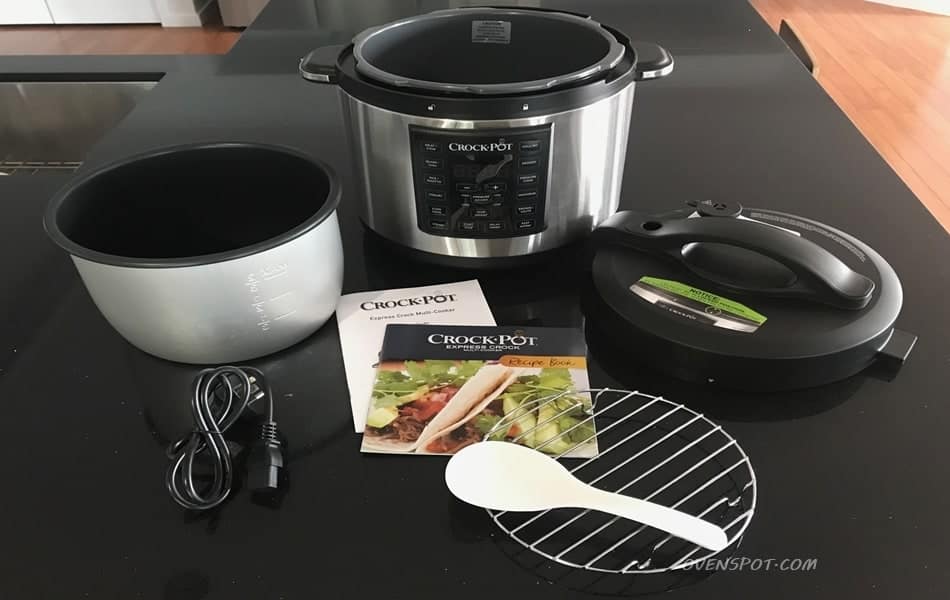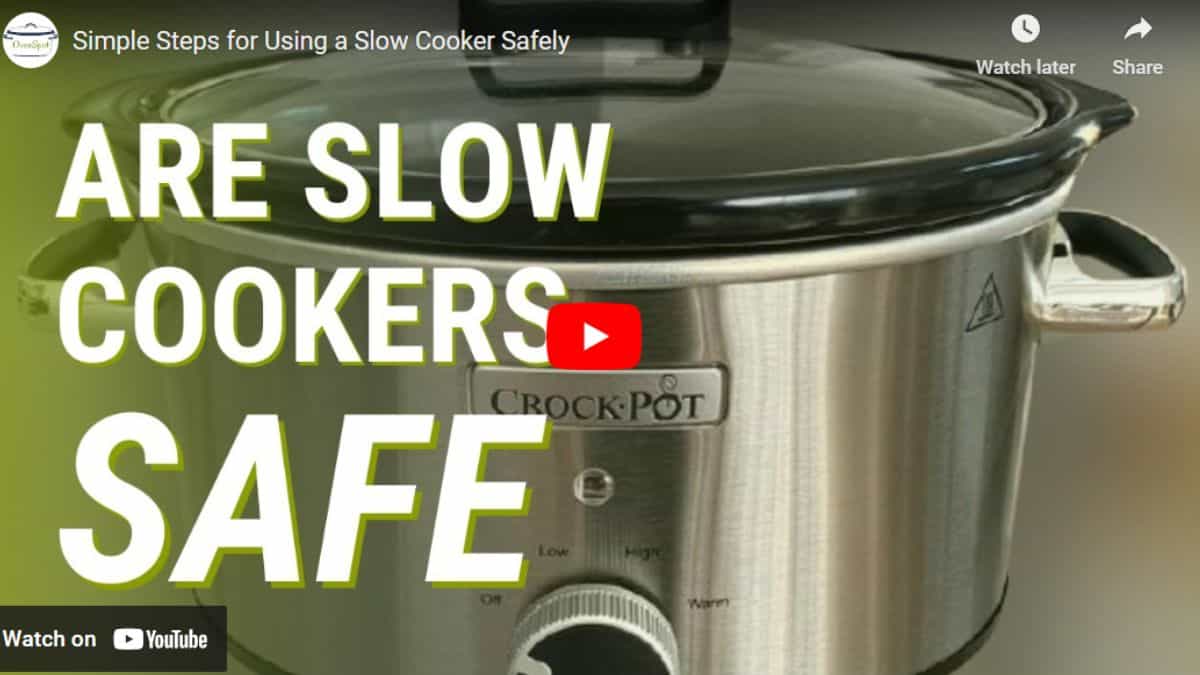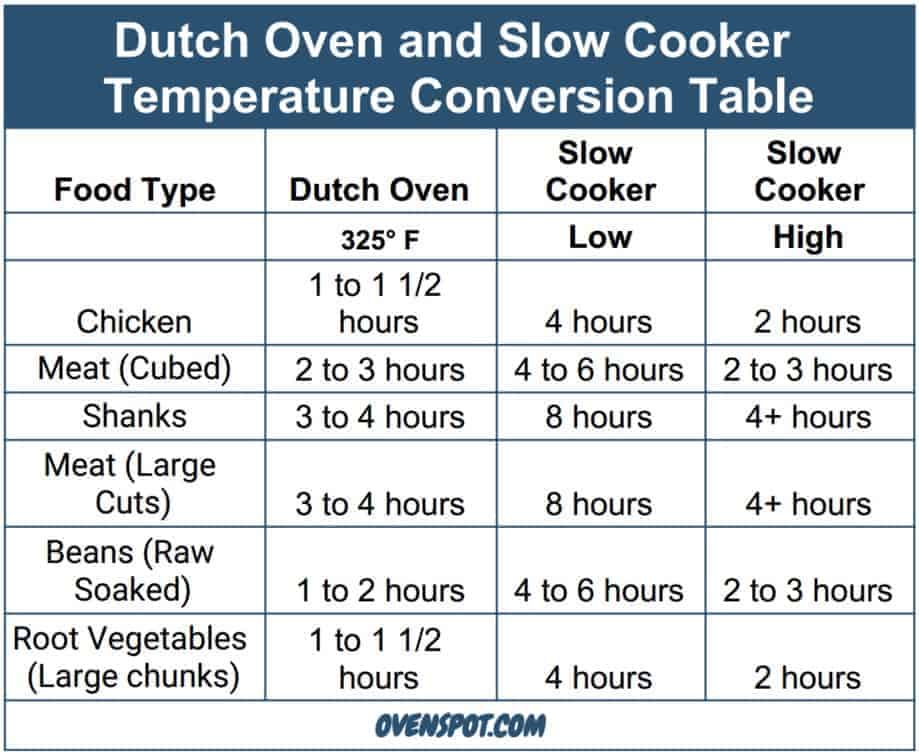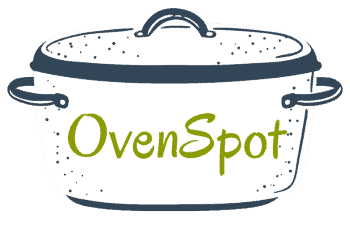Dutch Oven vs Slow Cooker: Which Pot Do You Need
Yes, a Dutch oven can be used as a slow cooker! Dutch ovens unequivocally produce far superior-tasting dishes. Any professional chef will agree. Slow cookers come into their own because it is chop, set, and forget cooking appliance geared around convenience.
Before researching what the best piece of cookware is for your needs, a Dutch oven or a slow cooker, also known as a Crock-Pot, you need to understand the fundamental differences between each cooker.
Dutch ovens are slow cookers made of cast iron, which heats up evenly and slowly at low heat settings on external heat sources. You can braise, saute, and brown before cooking. A slow cooker, on the other hand, has an inner pot with a fitted lid that sits inside a housing that is heated electrically.

You will note that both cookers can perform the slow cook action so that recipes can be adapted for either cooking pot. But the end dish with full, rich flavors is not the same.
When purchasing cookware, people are often tempted to go for a product that costs less, even if it doesn’t deliver as well on performance. If you have started your buying research, you will know that a slow cooker will cost you considerably less than a quality Dutch oven.
Most cookware is cheaper than Dutch ovens, come to think of it.
However, there isn’t a considerable amount of cookware on the market that can deliver as well as a Dutch oven. In the context of this blog, the jury is still out on whether a slow cooker can produce better results than a Dutch oven and whether those results can be produced as efficiently. More on that later, though.
Disclaimer: I earn from qualifying purchases on my website as an Amazon Associate. If you purchase through links from this website, I may get a small share of the sale from Amazon and other similar affiliate programs.
What Is a Dutch Oven
If you are familiar with these pages, you will likely already be pretty clear on what a Dutch oven is. I will refresh your memory anyway, though.

A Dutch oven is a form of metallic cookware, making it the direct opposite of a slow cooker. While your slow cooker is a form of ceramic or porcelain cookware, your Dutch oven is primarily made from cast iron.
While Sunbeam is probably the most recognizable slow cooker manufacturer, the most recognizable name in Dutch ovens is probably Staub or Le Creuset.
You have encountered Le Creuset products in the store. They stand out from other forms of cookware because they are usually coated in enamel both on the inside and the outside, and the colors used for that coating are generally bright.
Le Creuset Dutch ovens light up a room, whereas most slow cookers look typically “state of the art” on the outside. That is to say, shiny and silver, with a glass lid. DULL.
Not only are the lids on slow cookers usually made from glass, but they are also dome-shaped. Dutch oven lids are flat and heavy.
Slow cookers are reliant on electricity as a heat source for cooking. In contrast, Dutch ovens can cook food on all heat sources, including campfires.
Dutch ovens get so hot you can sear, brown, and saute in the pot, sealing in the goodness, before adding other recipe ingredients, then slow cooking.
A must-read before using a Dutch oven for the first time is my article to learn how to use a Dutch oven on a stovetop.
Finally, when you purchase a Dutch oven, you get just that. There are no extra casing or housing units, no wires, just the pot.
This OvenSpot article explains in detail the differences between Seasoned Raw Cast Iron and Enameled Cast Iron
What Is a Slow Cooker (Crock-Pot)?

In the context of this article, it would be prudent to also wrap your head around what a slow cooker is and establish just how much it differs from a Dutch oven.
Depending on where it is in the world that you live, you might have also come across something called a crock-pot. The definition of slow cookers and crackpots is sometimes confusing. A crockpot is a slow cooker, and Crock-Pot is a brand that makes slow cookers and many other brands.
Learn about the differences between a crockpot and a slow cooker, including an in-depth explanation of the brand names.
The slow cooker is the official name and was invented by Irving Naxon. His patent was registered in January 1940. The cooker was named the Naxon Beanery and rebranded Beanery in 1972.
Crock-Pot didn’t make an appearance until the 1970s and, still today, is a market leader in appliances and cookware.
Many people who own slow cookers have also purchased them from Sunbeam, which has been a manufacturer of electrical appliances for more than a century now.
That is a defining feature of slow cookers. They are electrical cooking appliances. That is to say, electricity is the only heat source for slow cookers. That is something worth thinking about at greater length.
The traditional manual or basic slow cooker is a form of non-metallic cookware. That is also probably a vital detail to consider before you purchase one. There are questions to be had about durability or fragility. Non-metallic cookware can break quite easily.
Most slow cookers are either made from ceramic or porcelain. Most of the time, the ceramic or porcelain slow cookers will be surrounded by a metal housing.
For those who are not entirely clear on this, you will put the slow cooker in the metal housing (it comes with the product), which will also act as the heat source for the slow cooker.
Think of it as a pot within a pot. So, you can take the slow cooker insert in and out of the metal housing.
This easy removal of a slow cooker insert is also a helpful detail for those who wonder about cleaning the slow cooker.

Modern slow cookers also have slow cooker inserts that can be used with other heat sources when removed from the slow cooker casing. The Crock-Pot Sear & Saute is the one I own.
Along with standard slow cooking features, it comes with a built-in searing and sauté setting. The bonus is a DuraCeramic removable cooking insert that can be used in the oven and on gas, electric, and induction cooktops.
Other brands like All-Clad (Below) offer similar versatile slow cooker combinations offering an aluminum insert that is oven-safe (up to 400°F). They can be used on some (electric & gas) but not all cooktops.
Dutch Oven vs Slow Cooker & Crock Pot Comparison Table
A convenient quick breakdown of the differences between Dutch ovens and slow cookers or crockpots.
| Electrical appliances and cords should be checked regularly, and elements kept free of debris | Cast Iron | Slow Cookers & Crock Pots |
|---|---|---|
| Material Construction | Raw cast iron = 98% iron and 2% carbon. Also, cast iron with a virtuous enameled coating | Metal casing with stoneware or cast aluminum insert |
| Design | Dutch ovens, French ovens, and Cocotte sturdy cooking pots with heavy lids for use on most heat sources | Generally, it is a lightweight electrical casing. Insert heavier with a vented glass lid. Manual, digital, programmed, and wifi slow cookers are available |
| Shapes | Round and oval | Round, oval, rectangle, and square |
| Sizes | 1-quart to a very large 14-quart Dutch oven in both seasoned and enameled cast iron | A mini slow cooker at 1 quart to a large slow cooker at 10 quart |
| Finish | Raw seasoned cast iron or a large range of shiny colored enamel coatings over raw cast iron with light or dark interiors | Limited colors or stainless steel outside with plastic contrasting trim; most lids are glass with a steam release vent |
| Heat Source | Seasoned Dutch ovens are suitable for all heat sources indoors and outdoors. Enamel Dutch ovens can be used naturally induction ready, ceramic, glass stovetop, gas, electric, or in the oven | Requires an electrical outlet and should be sitting on a flat, non-combustible countertop |
| Temperature | Temperatures up to 500 °F depending upon the cookware quality and design (knobs and handles should be oven safe) | Cooks slowly at a low temperature, generally between 170 and 280 degrees F, over several hours |
| Heat Retention | High | Low |
| Versatility | Slow cook, brown, sear, stew, boil, braise, and fry | Slow cook, braise, some units sear and sauté |
| Performance | Tight-fitting heavy lids promote the ultimate self-basting feature that results in a reduction in thick sauces and rich flavors | Slow cookers can achieve the fall of the bone types of dishes they are designed for. Unfortunately, due to the cookers’ condensation, they cannot reduce liquids. |
| Everyday Use | Easy-to-use one-pot cooking that should not be left unattended | An easy-to-use appliance. A timer is used to cook your dish. It will then revert to keep warm setting |
| Durability | Seasoned cast iron will last your lifetime and beyond. Enamel cast iron is not so long. | Inserts are not everlasting. An electrical appliance will last as long as it lasts. An electrical component may be required. |
| Clean Up | Seasoned cast iron wash by hand only. Enameled cast-iron Dutch ovens are dishwasher safe, but hand washing is advised | Some parts are dishwasher safe, hand washing is preferred |
| Maintenance | Season before first use, season regularly. Enamel Dutch oven seasoning is not required | Electrical appliances and cords should be checked regularly, and elements kept free of debris |
| CONS | Maintenance required, heavy, high-end brands expensive | Electrical appliances and cords should be checked regularly, and elements kept free of debris |
| Storage | Relatively compact Dutch ovens can be stored in cupboards and ovens with care | Slow cookers can be cumbersome to store |
| Price | Prices start at approximately $20 | Prices start at approximately $20 |
Can You Use a Dutch Oven as a Slow Cooker?
Yes, you can substitute a Dutch oven for a slow cooker. The main difference between a Dutch oven and a slow cooker is the heat applied to the cookware.
Dutch ovens can be used on almost any heat source, depending upon whether it is a seasoned cast-iron Dutch oven or an enamel-coated Dutch oven.
The seasoned cast-iron oven can be used on campfires, I would never put an enamel cast-iron Dutch oven on a campfire. It would produce wonderful meals but ruin the cooking pot.
Whereas a slow cooker is heated by electricity, and it is the only heat that can be used with this cooking pot.
Deep dive into how to use a Dutch oven as a Slow Cooker. Includes helpful tips to save you time when converting your slow cooker recipes to cooking in a Dutch oven.
Why You Might Buy a Slow Cooker Instead of a Dutch Oven
| Slow Cooker Pros | Slow Cooker Cons |
|---|---|
| Add all ingredients and turn the power on | Sealing or browning needs a separate pan as the slow cooker does not get hot enough |
| Your cooking time will be longer | Does not reduce liquids |
| It does not reduce liquids | |
| A lot of parts to clean | |
| Electrical cables and bulky casing to store |
1. Cooking Is Not Too Tricky With a Slow Cooker
It should take you six hours to complete a Sunday roast with a slow cooker, sometimes a little longer than that. For most of those six hours, the slow cooker does not need to be attended to.
While cooking something like a pork shoulder well is relatively tricky, preparing it in a slow cooker should not be too tricky, primarily because it will do most of the work for you.
2. Slow Cookers Are Ideal for Cooking Tough Cuts of Meat
Most people are intimidated by the kitchen, especially where there is a prospect of having to cook something like pork shoulder, beef chuck, or brisket. Especially if those cuts of meat are cheap. Cheap cuts of meat are generally tough to cook and eat.
The slow cooker is helpful because you will simmer your meal at lower temperatures than usual while using one.
When you cook for long periods, you will soften the connective tissue on meat associated with cheaper cuts.
Critically, that objective can be realized without toughening the muscle on the meat. If you are somebody who hates having to chew meat for extended periods – we guess that is everybody – then the slow cooker is the cookware that you probably want to be using.
3. A Slow Cooker Will Not Burn Your Kitchen
This would tie in with the first point we made about the slow cooker. In addition to you not having to attend to your meal for about six hours, there is also no fire hazard associated with the slow cooker, and that is because you are cooking at such a low intensity or heat.
Not only is your kitchen safe, but your food is also safe when using a slow cooker. I would, however, caution against cooking for much longer than the suggested period for a particular meal because the taste will probably be lost, and the food will not look great either.
A must-read article if you are using a slow cooker: Are Slow Cookers Safe: 11 Tips to Avoid Accidents

4. Slow Cookers Can Help You Save Energy
This can often be taken for granted because we live in a world where we have become used to the more traditional sources of electricity.
Because the slow cooker operates at such a low intensity, you can complete your meals while cooking with something as small as a 1-2kW solar panel.
The experts will tell you that slow cookers draw on less energy than that. So, do not let the fact that the slow cooker uses electricity deter you for one moment.
Find out if slow cookers are really as energy efficient as they say Slow Cookers: Energy Efficient or Not?
5. A Slow Cooker Does the Thinking for You
While this might depend on the brand of the slow cooker, more often than not, you can purchase a cooker that has a timer built into it. The purpose of that time is to monitor the time and intensity with which you have been cooking.
If it is established that the heat is too high after a certain period of cooking, the slow cooker will lower the heat automatically for you.
Learn about the benefits of slow cookers, including ten reasons to use them to improve your lifestyle.
6. Slow Cookers Are Easy to Clean
A significant redeeming quality of slow cookers is that you can prepare a whole meal in them, such as a stew or pot roast. You do not need more than one pot to cook, meaning there are fewer dishes to wash when you are done.
A slow cooker, because the food will not be burnt, is very easy to clean once you are done with it. You do not have that luxury with all the other cookware that you find in the kitchen.
Yes, people ask the question can you put a slow cooker in the dishwasher? So, I have answered it in depth.
7. Slow Cookers Are More Dynamic Than Most Cookware on the Market
Just thinking about preparing a whole meal in one pot can be a daunting affair, almost enough to put you off the whole idea of using a slow cooker. However, you will be genuinely surprised by how many meals you can prepare in a slow cooker and how easy it is to prepare most.
There are slow cooker recipes available all over the internet, and there are several experts on YouTube who have gone through the effort to show you how to prepare those meals. You will be startled to know that there is a considerable amount that can be achieved in a kitchen when you are using a slow cooker.
It is almost tempting enough to purchase this instead of a Dutch oven, but there is no reason why you cannot buy both forms of cookware.
Why You Might Not Buy a Slow Cooker Instead of a Dutch Oven
| Dutch Oven Pros | Dutch Oven Cons |
|---|---|
| One-pot meal preparation – the ability to sear, saute, or brown on the stovetop or in the oven | Easy clean enamel cookware – warm, soapy water |
| Easy clean enamel cookware – warm soapy water | Certain dishes will take a little more time if a fall-off-the-bone meal is what you are after |
| No electrical cables and bulky casing to store |
1. Heat Retention Is an Issue With a Slow Cooker
The lid of a cast-iron Dutch oven is always an important talking point for us. Dutch ovens have heavy lids that produce a tight seal on your pot.
The lids on most slow cookers are not nearly as heavy, and they are made from glass. Heat is allowed to escape a little too easily from slow cookers, but beyond that, the nutritional value in most of the food cooked in a slow cooker is lost a lot quicker.
This is particularly problematic when cooking vegetables in a slow cooker.
Loss of heat and nutrients are not problems you are likely to encounter when using a cast-iron Dutch oven.
Learn about slow cooking temperatures and what temperature slow cookers cook at!
2. Slow Cookers Not Being Attended Presents a Risk
A popular habit is to put food in a slow cooker and leave home for an extended period, only to return when you think the meal is just about ready. Ordinarily, there is no issue with this. It is a convenient and safe option.
However, there are times when you will have a power outage in your home. It is the nature of electricity – it is not always completely reliable.
It is evident then possible that this outage can happen while you are away from your home, while the slow cooker is on.
That will have an adverse impact on your meal and will probably ruin the whole exercise completely. Possibly render it a complete waste as the ingredients would most certainly be going bad.
A hot topic is whether you can leave a slow cooker unattended again. I have answered the question in this article.
3. Slow Cooking Can Pose Some Health Risks
Concerns have sometimes emerged for people who want to cook beans because of the carbohydrate-binding proteins that they have in them. They are toxic, but when you are cooking at high temperatures, this does not become an issue.
Heat destroys the carbohydrate-binding proteins in beans, but because you are operating at much lower temperatures with a slow cooker, the risks posed are significantly higher.
Complications associated with this can be avoided by soaking beans overnight and then draining the water or by boiling those beans for about 30 minutes before you start slow cooking.
There are other creative techniques available too, but the reality is that you will find yourself having to do additional work, only to cook very slowly and for long periods after that.
That can be off-putting for some who are already wary about the six hours of cooking.
We all want to know that cookware and appliances are safe to use. In this article, I answer the question Are slow cookers healthy?
4. Slow Cookers Present Consistency Nightmares
Ordinarily, when you are cooking, there is an option to improve the consistency of your soups and sauces by reducing the heat in your pot to a simmer. When you operate with a slow cooker, you have been at a simmer from the outset.
For that reason, there will naturally be no reduction, and what you tend to end up with is a runny product. The more seasoned cooks among you will be able to avoid this problem.
When there is a will, there is always a way. It is just that all of that unattended cooking will suddenly become a little more attended cooking.
Converting slow cooker times is easy when you follow the steps in my article on how to convert slow cooker times.
5. Slow Cookers Do Not Produce the Best Meals
The meals produced with a slow cooker are generally of very high quality. You will enjoy them, especially those tougher and cheaper cuts of meat that give so many folks trouble.
The runny sauces that a slow cooker produces usually require the dish to be moved to another cooking pot to reduce the liquid into an edible sauce. Never fear there are ways to use a slow cooker – learn how to thicken stews, sauces, and soups in a slow cooker.
There is no denying that a meal produced in a Dutch oven will always be better than what a slow cooker can give you.
Find out if a slow cooker is an appliance you need to purchase in my article Is a Slow Cooker Worth It?

Slow Cooker vs Dutch Oven – The Pork Test
Determining whether a Dutch oven is better than a slow cooker or not often rests heavily on what it is that you are cooking. For this blog post, we have thought it prudent to focus on pork shoulder, which can be very difficult to get just right.
The experts will tell you that the perfect Sunday roast takes six hours to get right, perhaps a little longer than that. There are two elements to cooking the perfect Sunday roast.
The first is the time that it takes to cook that roast, and the second is the intensity of heat at which you cook that roast.
Both elements are related. Cooking the Sunday roast with a Dutch oven or slow cooker will have a meaningful impact on whether you can strike the perfect balance, especially if you are preparing pork shoulder for family and friends.
The key details to consider here are the efficiency and the quality of the final product. Not everybody likes cooking, and not everybody likes food.
Some people like both – which means that efficiency and quality will carry the same weight under the circumstances.
Time and Heat
It is worth noting that in this test, the Dutch oven was placed into a kitchen oven for about four hours. While time is the key thing to note here, it is also worth noting that you could place the Dutch oven on an oven rack.
I keep mentioning how versatile the Dutch oven is because you can use it on multiple heat sources. So, extra points for that.
The Dutch oven was set at a relatively low and slow temperature.
The slow cooker was set on high, which is worth noting. For that reason, the test for the slow cooker was also conducted over about four hours.
Efficiency comes under the spotlight here.
BONUS: In my article Dutch Oven Temperature Guide I give you a complete guide to Dutch oven temperatures. It includes a briquette placement guide for using your Dutch oven outdoors. Don’t forget to download your FREE Dutch oven temperature & briquette or hot coal placement guide.
Aesthetics
A teacher once told the author of this blog that you eat with your eyes. If that were true, the Dutch oven beats the slow cooker, without even flinching.
The pork produced in the Dutch oven just looks juicy, crispy, and tasty.
The slow cooker’s pork looks dull and bland, uncooked even.
Eating Difficulty
The whole point of this slow-cooking technique is to make tougher meats easier to consume at the dinner table.
When you put your fork or knife into the pork prepared in the Dutch oven, the meat falls off the bone. It is effortless.
Nevertheless, the Dutch oven still wins that contest, hands down, regardless.
Dicing the pork produced in the slow cooker requires a little more effort. However, it is worth noting that this was only cooked for four hours and not six, as Jamie Oliver would probably suggest you go about it. That would also mean cooking at a lower heat intensity.

Ultimate Winner – The Proof of the Pudding Is in the Eating
Ultimately, we could discuss all of these talking points at length without really knowing just how well a slow cooker performs against a Dutch oven.
The best way to establish how good a slow cooker is against a Dutch oven is to conduct the good old BLIND TASTE TEST. So, here we go!
A group of people was recently consulted on what White Chicken Chilli tasted like in a slow cooker versus what it would taste like after being prepared in a cast-iron Dutch oven.
Here are some of the comments.
1. White Chicken Chili Prepared in a Slow Cooker
- “It could use a bit more flavor”
- “It could use a little seasoning”
- “It wasn’t super flavorful”
- “It is all a little bit mushy”
2. White Chicken Chili Prepared in a Dutch Oven
- “Wow, that’s a bit different”
- “I like the texture of the meat in this one”
- “The chicken is a bit more tender”
- “It is seasoned better”
- “This one has a bit more kick to it”
It should not come as a surprise to anybody that all eight of the participants in the blind test said they would eat more of the meal they were served if it was prepared in a Dutch oven.
While you are welcome to purchase both a Slow Cooker and a Dutch Oven, I honestly think it is a no-brainer. The Dutch Oven beats the Slow Cooker every single time.
Can You Substitute a Dutch Oven for a Slow Cooker
As you can see from the comparison above, the Dutch oven is the original slow cooker that has been around for hundreds of years.
Why Is Cooking in A Dutch Oven Better?
Cooking in a Dutch oven is better due to the cast-iron heat retention capabilities. The pot can be heated from the bottom or inside an oven and will heat from all sides. Combine this with the heavy lid that keeps the steam and moisture inside the pot, and you have tender meals every time.

Final Thoughts – Dutch Oven vs Slow Cooker (Crock-Pot)
Well, you have the proof in the cooking and the tasting of the result of two of the same recipes prepared in different “but similar” cooking pots.
I agree with the test testers that Dutch ovens will give you the perfect dish every time just by following the traditional Dutch oven cooking principles.
But, if time is not your friend, I would suggest the next best cooking appliance. This is one where you can produce healthy, nourishing meals made from fresh ingredients all in one pot – the slow cooker.
Dutch Oven Recipes
Don’t forget to check out some of my favorite Dutch oven recipes.
One-Pot Cooking Rocks!

Michelle
Hi, I’m Michelle, the founder, owner, author, and editor of OvenSpot. My passion for one-pot cooking commenced when I was working to prepare cafeteria lunches for school students. I am now on a mission to assist you in choosing the cooking pot or appliance you will use daily. As well as in-depth information to assist you in using and caring for your cookware and appliances.
Questions? Reach out to Michelle at [email protected]

